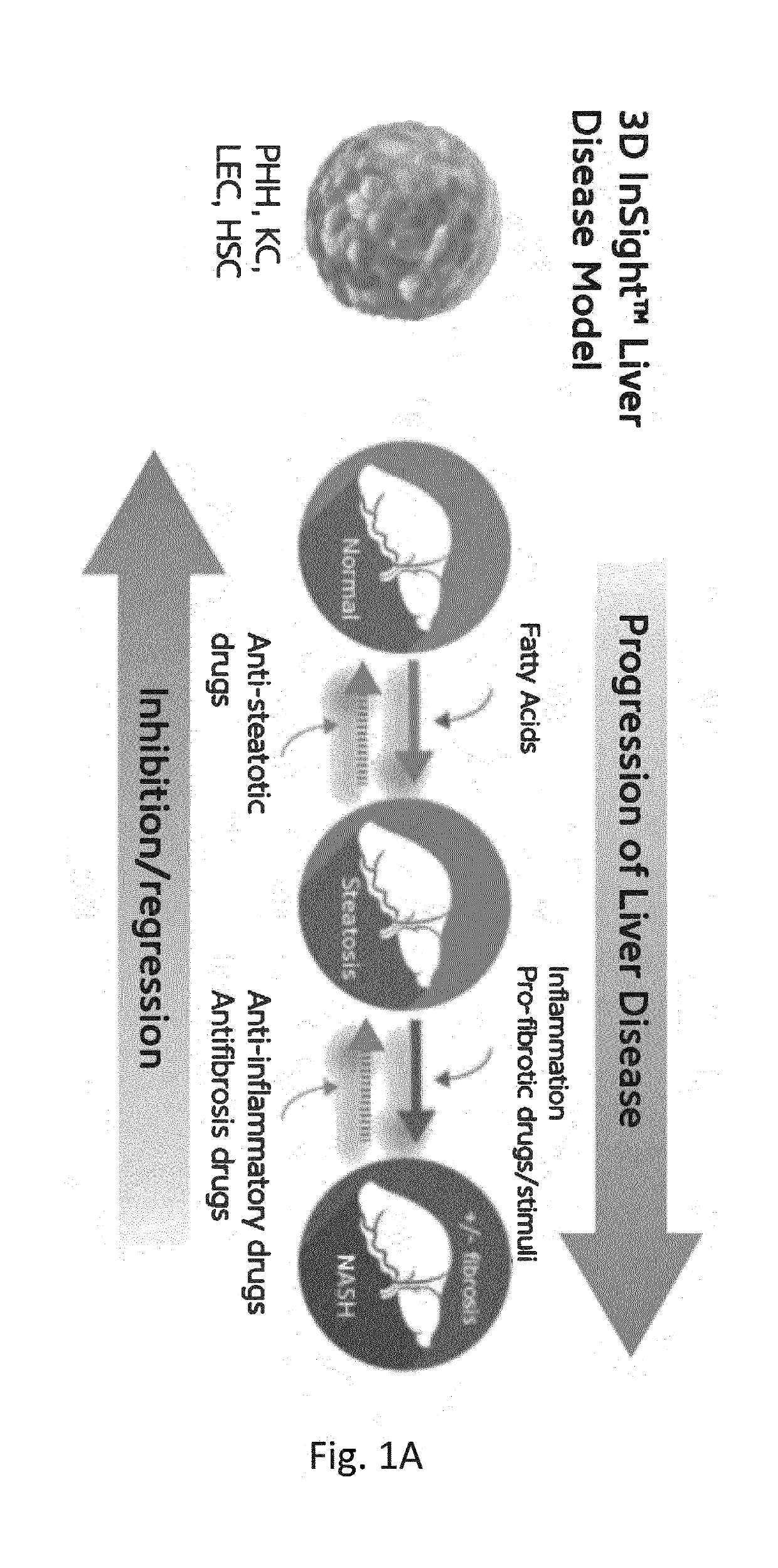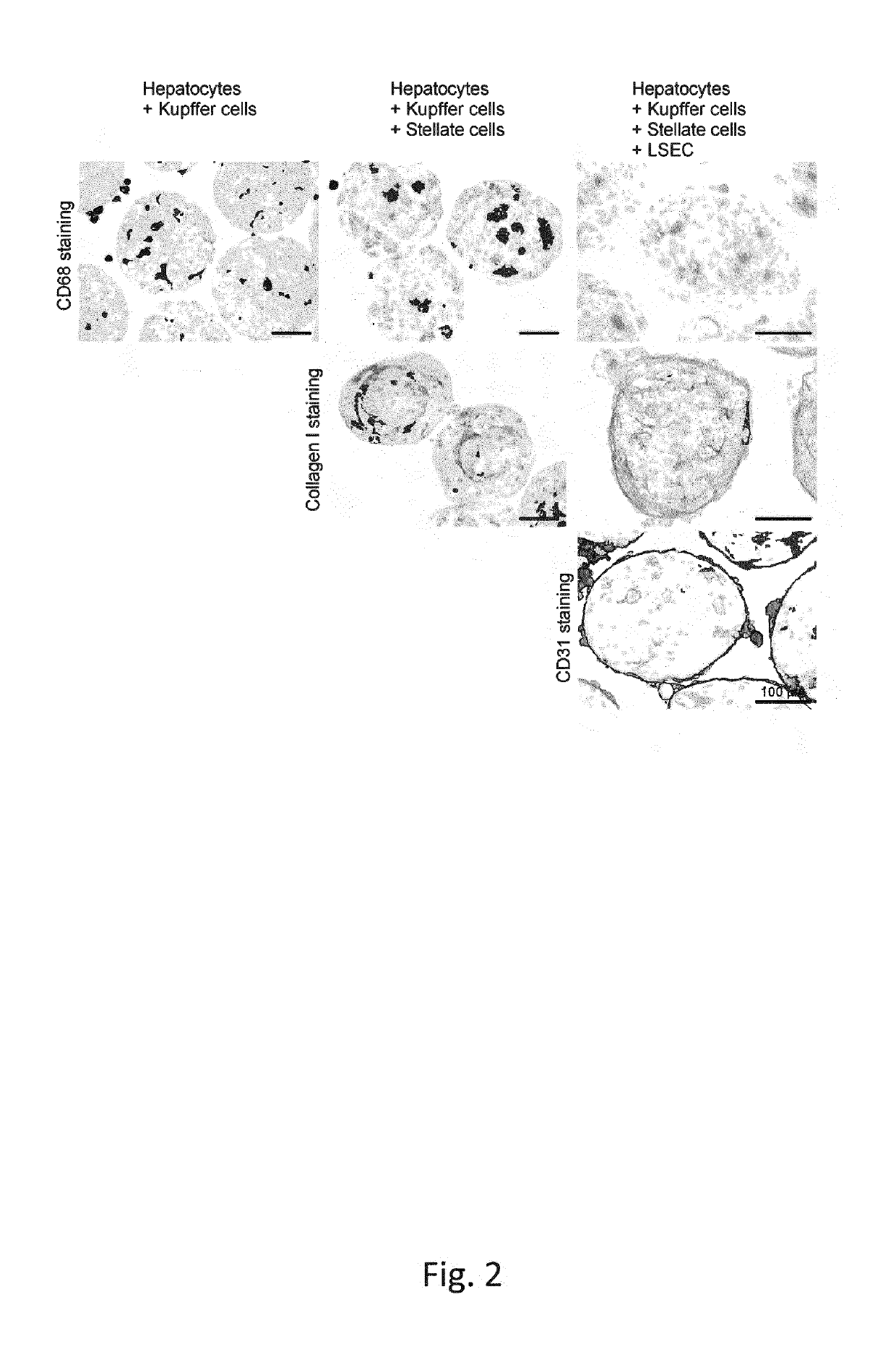Screenable liver disease models and methods
a liver disease and model technology, applied in the field of 3d tissue culture, can solve the problems of limited preclinical application of hsc into myofibroblasts, limited use of preclinical applications of hsc, and inability to describe the reconstitution of liver, and achieve the effect of superior physiological behavior
- Summary
- Abstract
- Description
- Claims
- Application Information
AI Technical Summary
Benefits of technology
Problems solved by technology
Method used
Image
Examples
example 1
Production Of Triple Cell Type Spheroidal Microtissues (Hepatocytes, Kupffer Cells, Stellate Cells)
[0197]After growth in 2D culture homo- and heterotypic microtissues were produced in hanging drops using InSphero's GravityPLUS™ (InSphero) platform. For protocols see WO2015158777A1, the content of which is incorporated by reference herein[0198]First, hepatocytes and hepatic stellate cells were detached from cell culture flasks[0199]Therefore, medium was aspirated and the cell monolayer was washed with phosphate buffered saline (PBS)[0200]Detaching of hepatocytes and HSCs was by Trypsin treatent[0201]After optical confirmation of dissociation, thaw / wash medium was added, stopping the enzymatic reaction[0202]Kupffer cells were thawed and directly used for MT production[0203]Hepatocytes, HSCs and KCs were separately washed in thaw / wash medium by centrifugation[0204]After the centrifugation step, the cells were resuspended in thaw / wash medium[0205]Their cell number and viability was asse...
example 2
Coating Of Spheroidal Microtissues With Liver Endothelial Cells (LEC)
[0207]After The artificial spheroidal microtissue formation (Day 4), LEC have been thawed, washed with LEC Coating Medium—and centrifuged[0208]In addition to the centrifugation step, the cells were resuspended in LEC Coating Medium and their cell number and viability has been assessed[0209]For LEC seeding and coating of the spheroidal microtissues a cell suspension of the desired composition was prepared in LEC Coating Medium[0210]spheroidal microtissues are being provided in suitable wells or vessel[0211]5 μ of the LEC suspension are dispensed to each well or vessel.[0212]LEC sink down and get in contact with the microtissues and the extracellular matrix surrounding them[0213]After 2 days of incubation, microtissues are fully coated with LECs
example 3
Induction Of Steatotic Phenotype by Lipid Loading of Liver Microtissues
[0214]Dissolve FFA-free BSA at RT for 1 h in H2O for desired stock solution concentration[0215]Dissolve desired amount of OA-Na in 1 mL 0.1 M NaOH→at 70° C.[0216]Dissolve desired amount of PA-Na 1 mL 0.1 M NaOH→at 70°[0217]Keep the FFAs on 70° C., while the BSA is placed on 37° C.[0218]Mix FFA with BSA with a magnetic stirrer (for 30 min)[0219]Dilute BSA with 0.1 M NaOH→vehicle control[0220]Cool down to RT, sterile filter, aliquot and freeze.[0221]For a final fatty acid (FA) solution dilute master stock in medium.[0222]Replace medium of liver microtissues with FA-containing medium and incubate 2-7 days.
[0223]Oleate (OA), a monounsaturated omega-9 fatty acid, incorporates in hepatocytes within small lipid droplets (microvesicular steatosis), while palmitic acid (PA), saturated hexadecanoic acid, shows a rather macrovesicular phenotype (FIG. 3A1). Lipid accumulation is the first step for recapitulating NASH (Non-Al...
PUM
 Login to View More
Login to View More Abstract
Description
Claims
Application Information
 Login to View More
Login to View More - R&D
- Intellectual Property
- Life Sciences
- Materials
- Tech Scout
- Unparalleled Data Quality
- Higher Quality Content
- 60% Fewer Hallucinations
Browse by: Latest US Patents, China's latest patents, Technical Efficacy Thesaurus, Application Domain, Technology Topic, Popular Technical Reports.
© 2025 PatSnap. All rights reserved.Legal|Privacy policy|Modern Slavery Act Transparency Statement|Sitemap|About US| Contact US: help@patsnap.com



